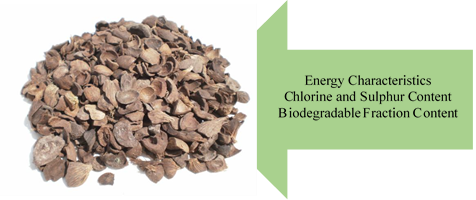Palm kernel shells are the shell fractions left after the nut has been removed in the palm oil mill. It is a well-known biomass product because of its small size and high energy level in calorific values. Because of its high calorific values (4000 Kcal/kg on average) and low contents of ash and sulphur, palm kernel shell has become an attractive renewable energy recourse, especially in countries with less fossil energy storage, such as Japan, Korea, and Europe.
As a biomass waste product, palm kernel shell has high calorific value and contains residues of palm oil. Moreover, compared to other industrial fuel recourses, the palm kernel shell is easier to handle, store, and to transport due to its small size and optimal natural density (1.1 g/cm3). Furthermore, because of the very low ash and sulphur contents, burning of palm kernel shell releases much less harmful gases and greenhouse gases into the environment. Besides, palm kernel shell can be used with coal to generate thermal power with lower coal consume and less carbon dioxide emission. Palm kernel shell also can be made into high performance activated charcoal which can be used to recover solvent, clean the air, purify the water, and so on.
Although the palm kernel shell has gained increasing popularity as a fuel resource, its quality has to be strictly monitored as to meet certain standards. The bioenergy laboratory at Lifeasible is dedicated to providing our clients from both academia and industry with robust technical and scientific services for the quality analysis of palm kernel shell products.
Analysis of energy characteristics, including net calorific value, total moisture content, ash content, etc.
Net calorific value is a fundamental parameter for the evaluation of fuel usability. The calculation of net calorific value of fuel is based on the combustible components, mineral substances (ash), and moisture content. Moisture content in biomass depends on various factors, such as plant type, vegetation period and atmospheric conditions under which a plant is harvested, transported, and stored. In addition, we also provide analysis services of nitrogen content, alkali content, and pH.
Analysis of chlorine and sulphur content
Chlorine and sulphur contents in plants results from their natural presence in soil as well as applied agrotechnical treatments. A considerable increase in chlorine content in biomass can be resulted from soil contamination, strong salinity of water and so on.
Analysis of biodegradable fraction content:
The minimum dry and ash free biomass (biodegradable fraction) in palm kernel shell samples should be no less than 97 % by mass; otherwise the fuel cannot be classified as biomass due to insufficient energy value.
Lifeasible has experienced experts in all aspects of biomass energy. We can provide you with tailored services for palm kernel shell biomass fuel testing. Our testing services are reliable and cost-effective, complying with the international standards (e.g., ASTM, IP, API, EN, ISO, EPA, etc.). We also can develop new methods and/or optimize the current methods to meet customers’ diverse requests. Welcome to Contact Us for questions or inquiries and we will be more than happy to help you.
 Figure 1. Quality testing of palm kernel shell as biomass fuel
Figure 1. Quality testing of palm kernel shell as biomass fuel